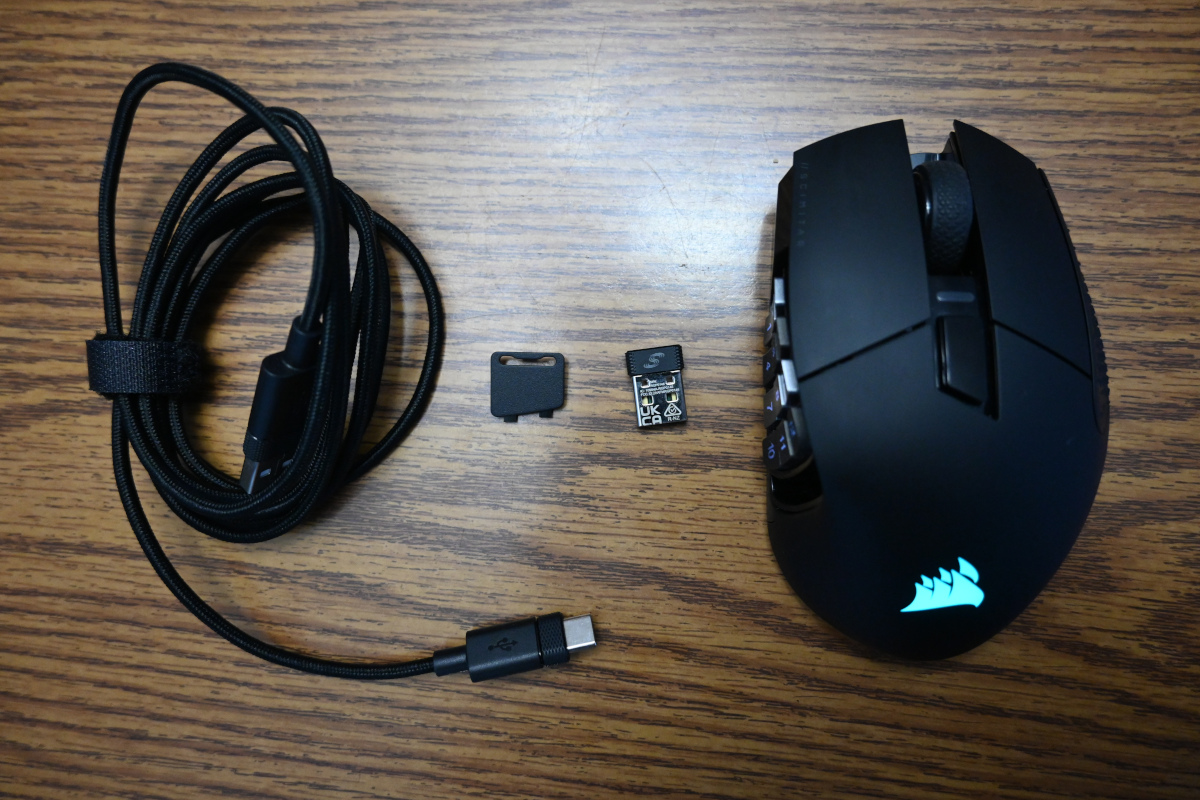Search
[{{{type}}}] {{{reason}}}
{{/data.error.root_cause}}{{{_source.title}}} {{#_source.showPrice}} {{{_source.displayPrice}}} {{/_source.showPrice}}
{{#_source.showLink}} {{/_source.showLink}} {{#_source.showDate}}{{{_source.displayDate}}}
{{/_source.showDate}}{{{_source.description}}}
{{#_source.additionalInfo}}{{#_source.additionalFields}} {{#title}} {{{label}}}: {{{title}}} {{/title}} {{/_source.additionalFields}}
{{/_source.additionalInfo}}- Details
- Category: Hardware
- By Jason Gress
- Hits: 1504
Corsair Scimitar Elite Wireless MMO Gaming Mouse

Corsair Scimitar Elite Wireless MMO Gaming Mouse
Specifications:
Corsaor Marksman 26k DPI optical sensor, with 50g acceleration and adjustable lift-off distance
Sixteen fully programmable buttons, with twelve by the thumb
Patented Key Slider Side Panel
2.4GHz Slipstream Wireless via USB-A Adapter
Up to 2000Hz polling rate
Bluetooth Wireless Connectivity
USB Wired Connectivity via USB-C port
RGB Lighting
On-board memory - stores button and RGB LED color settings with up to three on-board profiles
Optical switches for main buttons, lasts 100 million clicks
Ergonomic shape, with textured ring finger grip
Fully customizable with Corsair iCUE software
Weighs 114 grams
High-quality fabric 1.8 meter USB-C to USB-A cable
MSRP: $129.99
(Amazon Affiliate Link)
Thank you Corsair for sending us this mouse to review! I've been a fan of MMO mice, those with typically a dozen buttons on the side, for a long time. While I rarely play MMO games anymore, I used to, and those games, along with a some other single player titles (like Kingdoms of Amalur, some FPS games, and some other RPGs), heavily use the numbers row on the keyboard. Having them on the mouse instead can really help keep your left/keyboard hand focused on movement, while the right handles aiming and weapon or skill selection. Once you get used to having that number pad for certain kinds of games, it's really hard to live without it. It may not be for everyone, but it's certainly for me. I've owned and heavily used MMO mice for close to ten years now. My first one was a Razer Naga 2014, that I started having double click issues with, so I gave it to my brother; fortunately he didn't notice those issues, and used it for a long time. I then moved to the original yellow Corsair Scimitar, which I loved, but it eventually failed on me. It had two flaws: one was that it required iCUE running to control the side buttons, as it didn't support onboard profiles. (This was fixed in later models.) The other flaw was that the middle click and scroll wheel died on it. Unfortunately, it was out of warranty, so I retired it. Good mouse otherwise. From there, I bought a Razer Naga Trinity. Great mouse, but that one also developed the double click bug, like the 2014 model did. I ended up getting it replaced under warranty, but I was so paranoid that the double click bug would return, I purchased a Razer Naga Pro (2020 version), which has optical mechanical switches for its buttons. That mouse is pretty good, and still works fine, but it's heavy, has a USB-Micro charging port, and the charging dock is a separate purchase that costs extra. It also didn't like something about my old house's office, as the wireless signal was unreliable there. That no longer seems to be the case where I live now, though. Ironically, I ended up not using the Naga Pro all that much because we started getting more mice to review maybe six months or so after I bought it, and I discovered I prefer lighter mice for most day-to-day use. But I still brought it out on occasion, especially with games that benefit from the button layout. ROCCAT's Kone XP line claims to be an MMO mouse, but I'm sorry, if you don't have twelve buttons on the side, it's just not the same. So when Corsair recently launched their Scimitar Elite Wireless, I jumped at the chance to review one, as I like many aspects of it more than the Naga line I felt stuck with for MMO duties.
Strong Points: Best side buttons of all MMO gaming mice I've tried; good wireless performance; comfortable; lighter than some MMO mice; onboard profiles work great; nice sensor; fantastic battery life; two-year warranty
Weak Points: A bit more sensitive to surfaces than some of my mice; easy to lose the storage door for wireless transmitter storage; no charging dock (not a huge con)
I have to say, there is a whole lot to like about this mouse. It's lighter than most MMO mice; while 114 grams isn't exactly light, it's on the lighter side as far as MMO mice go. The contour is comfortable for me, though my hands are on the larger side. The scroll wheel feels nice to use, and the DPI adjustment button is in a good place, and there is a dedicated LED that helps you know what DPI setting you are on. Unfortunately you do have to cycle, as there are no dedicated up and down buttons, but that's okay. The left and right mouse buttons use optical mechanical switches, and feel great. The twelve-button side panel uses all mechanical switches, which also feel great and make a satisfying click sound. I have been spoiled and no longer appreciate mushy membrane side buttons common on less expensive mice. There are two RGB LED zones, one by your palm, that highlights the logo. The other LED zone is the twelve-button side panel. You can set it to a static color, or one of many color patterns. In the 'Lighting Effects' section of iCUE, you can set it to almost two dozen different lighting types, per LED region. There are a ton of options. Under 'Hardware Lighting', you have one of five options, with much simpler options being available. These include static colors, watercolor, color pulese, color shift, and rainbow. The good thing about these is that they are always available - even in your BIOS or at another computer without iCUE; once you upload them to your mouse, you're good to go. If you are simple like me, you may want to make your Hardware Lighting and Lighting Effects match, but if you want wild colors while iCUE is running, feel free! The side button key assignments are quite flexible, and unless you want to launch an app or perform an obscure function, in this case 'Hardware Key Assignments' probably has everything you need. Unfortunately, just like with the lighting, you need to program with 'Hardware Key Assignments' and 'Key Assignments' while iCUE is running, which I'm not a huge fan of. As it is assigning keys is kind of clunky, but thankfully unless you're a macro nut, you probably don't have to change this very often. One thing I did discover on accident though is that it shows up to the computer as a virtual keyboard, which does make sense. But make sure you put it after your actual keyboard in the USB device chain, or your motherboard might choose the mouse as your keyboard when trying to access the UEFI! Other useful features include customizing the DPI selection, surface calibration, and setting the USB polling rate. DPI is dots per inch, and affects how much your cursor moves when you move your mouse. Lower is better for competitive first-person shooters, as having more movement range can help you be more accurate. Higher is often better for desktop use or some strategy games, as moving your mouse less can often be more ergonomic. That's why the selector is so handy; you can change the DPI based on whatever you are doing. My mousepad is several years old, and this mouse didn't like parts of it. Thankfully, surface calibration seems to have resolved this mouse's issues with this mouse pad. My other mice didn't need the calibration at all, but at least I had an easy way to resolve this problem.
The USB polling rate is how often your computer receives updates from the mouse. In wireless dongle mode, you can set it via a separate device in iCUE, with a maximum of 2,000Hz. 1,000Hz has been the standard on even high-end mice up until very recently. You can set the polling rate for the USB connection mode separately for wired and wireless. Those settings range from 125Hz/8ms, to again, 2,000Hz. If you care about CPU load, stick with 1,000Hz or below, though if you have a high-refresh rate screen especially, you can absolutely tell if it's below your refresh rate x 2. I usually set most mice to either 1,000Hz or the maximum, depending on the mouse. Don't go below 500Hz if you play anything competitive. Also, consider Bluetooth mode more for convenience than anything high-performance; Bluetooth is great, but the polling rate is very low, typically around 125Hz or so, so while it may save battery life, don't use it this way if you care about gaming performance.





